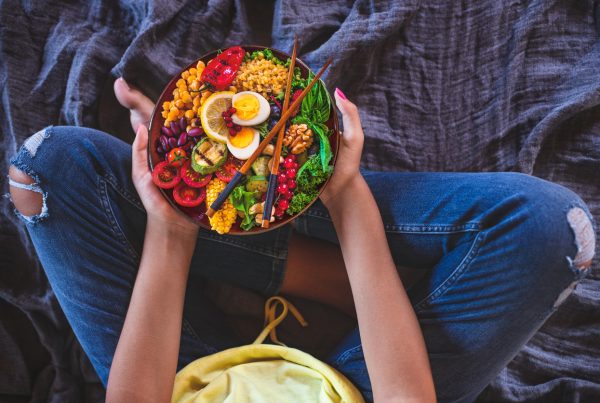Migraines are said to be the second most disabling condition in the world. Dr Linia Patel (PhD), RD looks at whether food may play a part in triggering migraines.
What does a migraine attack feel like?
You may get a headache from time to time. Everyone does. But an estimated 10 million adults in the UK – and about one billion people around the world – experience a moderate to severe throbbing pain on one side of the head. This is called migraine. Many people also have symptoms such as feeling sick, being sick and an increased sensitivity to light or sound.
Recent studies and research suggest that food and diet may play a part in migraines. Making changes to your diet may help to prevent migraine attacks or reduce their frequency. Keep reading for more on how this works and which foods to eat or avoid.
Who gets migraines?
Anyone can get a migraine; however, there are certain factors that make you more likely to get them. These are:
- Migraines affect around one in five women and around one in every 15 men. Researchers suggest that fluctuating female hormones are likely to be a factor. Oestrogen, one of the main female hormones, regulates the female reproductive system but it also happens to control chemicals in the brain that impact on the sensation of pain. A drop in oestrogen can cause a migraine in some women.
- Due to the hormonal influences, migraines most often begin at puberty and are likely to affect people of between 18 and 45 years of age.
- Around 90% of people who have migraine attacks have a family history of them.
There are other factors that can also trigger migraine attacks such as:
- some medications (i.e., birth control, steroids or prescription pain killers)
- stress and anxiety
- poor sleep quality
- changes in weather
- certain foods.
What foods can trigger a migraine?
Right now there is no definite list of food or drinks that do or don’t cause an attack. Sorry! Many people anecdotally claim certain things they eat or drink are triggers and I will share those foods with you later. Interestingly, recent research has found that it’s most likely not the foods that cause migraines but rather it’s the migraines that cause people to eat certain foods. Instead, the research suggests that low blood sugar may be a big culprit. Low blood sugar then causes a particular food craving. The key, therefore, is to control one’s blood glucose levels optimally.
With optimal blood glucose control in mind, skipping meals or fasting are, not surprisingly, commonly reported migraine triggers. Regularly eating a diet high in refined carbs, processed carbs and sugar also causes blood sugar levels to spike, leading to an outsized insulin response and an increase in inflammatory levels in the body which also make you more suspectible to attacks. Limiting your habitual intake of ultra-processed foods in favour of whole, unprocessed foods is generally good advice for everyone. Not only do ultra-processed foods play havoc with your blood sugar levels but they also contain additives like artificial sweeteners and flavourings that may be migraine triggers for people.
Anecdotally, the foods that may trigger migraines include:
- chocolate, due to the chemical beta-phenylalanine
- nitrate-rich foods, such as cured meats and hot dogs
- artificial sweeteners, especially aspartame
- tyramine, a chemical found in fermented foods, aged cheese and some kinds of fresh-baked bread
- alcoholic drinks
- monosodium glutamate (MSG), an additive often found in processed foods.
Practical tips for people who suffer with migraines
- Migraine attacks are often due to multiple factors. Stay aware. When you are stressed out, not sleeping well and not exercising, eating one of your food triggers may make it more likely to have an attack.
- Food triggers vary from person to person and can be difficult to figure out. Keeping a food diary along with a headache diary may help to identify a link.
- If you often get a food craving before a migraine comes, take note so you can start to prepare for what is coming.
- If you think a specific food is triggering your attacks, you may try to exclude the food for a month. Monitor your symptoms and see if they improve. Be careful about trying extremely restrictive diets without the help of a dietitian.
- Keep your blood sugar levels balanced. Remember moderation is the aim. Blood sugar levels that are too low or too high increase your risk of an attack. Focus on eating a balanced diet that is based on whole foods and less ultra-processed ‘junk’ food.
- Become a fish fan. Include omega-3 rich foods such as mackerel, salmon, mussels, seeds and legumes in your diet, as this helps prevent inflammation.
- Load up on magnesium-rich foods such as dark green leafy vegetables, unsalted nuts and seeds and whole oats in your diet. A magnesium supplement may also help women in particular during the PMS phase of the cycle when female hormones are at an all-time high.
Have you checked out Linia’s best-selling online educations?
- Nutrition for Menopause
- Gut Health – the power of the microbiome
- Low Carb: the evidence & application
- Sports Nutrition Basics
- Plant-Based Eating: The Essentials
- Food as Medicine? Food and inflammation
Which one do you fancy?
About the author

Dr Linia Patel has a BSc degree in biochemistry and physiology and has recently achieved a PhD in public health. Linia is a leading dietitian and sports nutritionist. Her passion is translating nutritional science into easy-to-digest and practical advice.
References
- The Migraine Trust, About migraine – The Migraine Trust
- Goadsby et al (2020), Pathophysiology of migraine. A disorder of sensory processing, Physiological Reviews, 97(2): 556-622.
- Pellegrino A et al (2018), Perceived triggers of primary headache disorders: A meta analysis, Cephalalgia, 36(6): 1,188-98.
- Hindiyeh N et al (2020), The role of diet and nutrition in migraine triggers and treatment. A systematic literature review, Headache, 60(7): 1,300-16.
- Gazerani et al (2020), Migraine and diet, Nutrients, 3(1,286): 1,658.
- Ghoreishy S et al (2022), Associations between potential inflammatory properties of the diet and frequency, duration and severity of migraine headaches: a cross sectional study, Nature, 12: 2,878.







